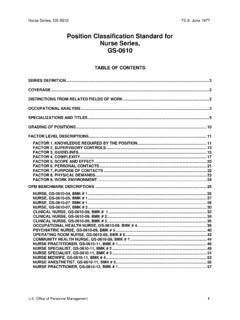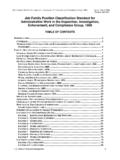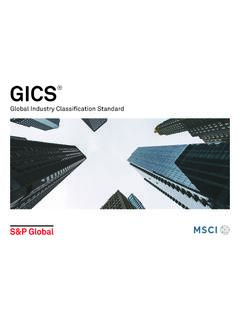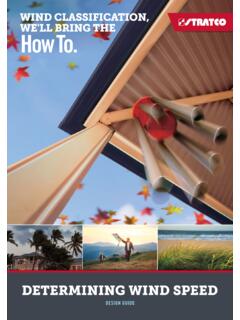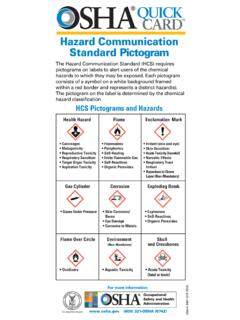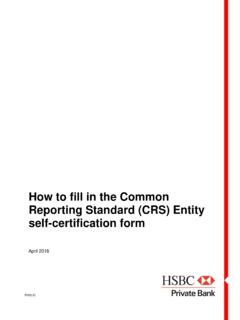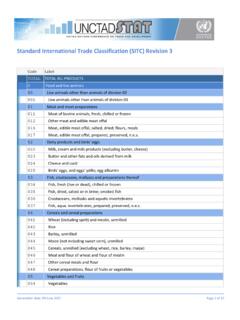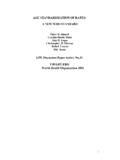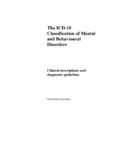Transcription of STATISTICS SINGAPORE - Singapore Standard Industrial ...
1 SINGAPORE Standard Industrial classification 2020 SINGAPORE Standard Industrial classification 2020 ISBN 978-981-14-5078-5 Copyright Statement Department of STATISTICS , Ministry of Trade & Industry, Republic of SINGAPORE Reproducing or quoting any part of this publication is permitted, provided this publication is accredited as the source. Please refer to the STATISTICS SINGAPORE Website Terms of Use ( ) for more details on the conditions of use of this publication. Statistical activities conducted by the SINGAPORE Department of STATISTICS are governed by the provisions of the STATISTICS Act (Cap. 317). The Act guarantees the confidentiality of information collected from individuals and companies. It spells out the legislative authority and responsibility of the Chief Statistician. The Act is available in the Department s Website ( ). SINGAPORE Department of STATISTICS SINGAPORE Standard Industrial classification 2020 i Preface The SINGAPORE Department of STATISTICS (DOS) develops national statistical standards and promotes their adoption and use in SINGAPORE .
2 The adoption and use of these standards in the collection, analysis and dissemination of STATISTICS ensures consistency and comparability of data, facilitating relevant and meaningful analysis as well as data sharing. The SINGAPORE Standard Industrial classification (SSIC) is the national Standard for classifying of economic activities undertaken by economic units. The SSIC is used for censuses of population, business surveys and administrative databases. The SSIC adopts the basic framework of the International Standard Industrial classification of All Economic Activities Revision 4 (ISIC Rev. 4) developed by the United Nations STATISTICS Division (UNSD). It is reviewed and updated periodically to reflect developments in the SINGAPORE economy, particularly the emergence of new economic activities as well as to align with changes in the international Standard . The SSIC 2020 is the fourteenth edition of the SSIC and supersedes the previous editions.
3 The SSIC 2020 is a significant update over the SSIC 2015 (Version 2018) edition. Detailed definitions are included for all five-digit level codes and the number of unique examples in the alphabetical index has increased significantly. The review of the SSIC was undertaken by a working group comprising representatives from many agencies, including the SINGAPORE Department of STATISTICS , Accounting and Corporate Regulatory Authority, Central Provident Fund Board, Economic Development Board, Infocomm Media Development Authority, Ministry of Manpower, SkillsFuture SINGAPORE and Workforce SINGAPORE . Inputs from other ministries and statutory boards have also been incorporated, where appropriate. I would like to thank all who have contributed to the review of the classification . Wong Wee Kim Chief Statistician SINGAPORE March 2020 ii SINGAPORE Standard Industrial classification 2020 SINGAPORE Department of STATISTICS Our Vision/Mission/Our Guiding Principles Our Vision National Statistical Service of Quality, Integrity and Expertise Our Mission We Deliver Insightful STATISTICS and Trusted Statistical Services that Empower Decision Making Our Guiding Principles Professionalism & Expertise We adhere to professional ethics and develop statistical competency to produce quality STATISTICS that comply with international concepts and best practices.
4 Relevance & Reliability We produce STATISTICS that users need and trust. Accessibility We make our STATISTICS readily available through user-friendly platforms. Confidentiality We protect the confidentiality of information collected by us. Timeliness We disseminate STATISTICS at the earliest possible date while maintaining data quality. Innovation We constantly seek ways to improve our processes, leveraging on new technology where feasible, to deliver better products and services to users. Collaboration We engage users on data needs, data providers and respondents on supply of data, and undertake the role of national statistical coordination. Effectiveness We optimise resource utilisation, leveraging on administrative and alternative data sources to ease respondent burden. SINGAPORE Department of STATISTICS SINGAPORE Standard Industrial classification 2020 iii Contents I PART I: INTRODUCTION AND METHODOLOGICAL NOTES.
5 1 1. Introduction .. 1 2. Structure of the SSIC .. 2 Economic Activity .. 2 Economic Unit .. 3 Structure of the classification .. 4 Detailed Definitions, Alphabetical Index and Correspondence Tables .. 6 3. Application of the classification .. 7 Basic Principles .. 7 Principal Activity and the Top-Down Method .. 7 Value Added Substitutes .. 8 Treatment of Vertical Integration .. 9 Economic Units not yet in Operation .. 9 Outsourcing .. 9 Online Marketplaces .. 10 Retail of Self-Produced Goods .. 11 Government Activities .. 11 Repair and Maintenance .. 11 4. Comparison with SSIC 2015 (Version 2018) .. 11 Overview .. 11 Inclusion of Five-Digit Definitions for Economic 13 Removal of Obsolete Codes .. 13 Improvements to Alphabetical Index .. 13 New Five-Digit Codes for Online Marketplaces .. 13 Merging of Retail Sale Channels .. 14 Re-scoping of SSIC 854 Other Education .. 14 PART II: classification STRUCTURE OF SSIC 2020 .. 15 Section A: Agriculture and Fishing.
6 16 Section B: Mining and Quarrying .. 18 Section C: Manufacturing .. 19 Section D: Electricity, Gas, Steam and Air-Conditioning Supply .. 40 Section E: Water Supply; Sewerage, Waste Management and Remediation 41 Section F: Construction .. 42 iv SINGAPORE Standard Industrial classification 2020 SINGAPORE Department of STATISTICS Section G: Wholesale and Retail Trade .. 45 Section H: Transportation and Storage .. 54 Section I: Accommodation and Food Service Activities .. 57 Section J: Information and Communications .. 58 Section K: Financial and Insurance Activities .. 62 Section L: Real Estate Activities .. 66 Section M: Professional, Scientific and Technical Activities .. 67 Section N: Administrative and Support Service Activities .. 71 Section O: Public Administration and 75 Section P: Education .. 76 Section Q: Health and Social Services .. 78 Section R: Arts, Entertainment and 80 Section S: Other Service Activities .. 81 Section T: Activities of Households as Employers of Domestic Personnel.
7 84 Section U: Activities of Extra-Territorial Organisations and Bodies .. 85 ACKNOWLEDGEMENTS .. 86 DETAILED DEFINITIONS, ALPHABETICAL INDEX AND CORRESPONDENCE TABLES (These can be found on the STATISTICS SINGAPORE Website in MS EXCEL or PDF format and may be updated periodically.) SINGAPORE Department of STATISTICS SINGAPORE Standard Industrial classification 2020 1 Part I: Introduction and Methodological Notes 1. Introduction The SINGAPORE Standard Industrial classification (SSIC) is designed for use in the collection of data ( censuses, surveys, administrative records) that requires the classification of economic activities undertaken by economic units. It is also used in the compilation, presentation and analysis of a wide range of economic STATISTICS . To ensure the continuing relevance of the SSIC, the classification is revised and updated regularly, taking into account recent developments in the economy.
8 DOS led a multi-agency working group in the revision of the SSIC and consulted public agencies for their views on the classification . The deliberations and consultations ensure the SSIC would continue to meet the classification needs of users and producers of economic data. Similar to earlier versions of the SSIC, the SSIC 2020 adopts the basic framework of the International Standard Industrial classification of All Economic Activities Revision 4 (ISIC Rev. 4) for international comparability, with appropriate modifications and updates to take into account changes in SINGAPORE s economy and users requirements. There are significant updates to the SSIC 2020 compared to the SSIC 2015 (Version 2018). Detailed definitions have been included for all the 1,023 five-digit SSIC codes, and the number of unique examples in the alphabetical index has increased by more than 1,000. New five-digit codes have been added to track emerging economic activities like online marketplaces for goods and services and Continuing Education and Training (CET) services.
9 Part I: Introduction and Methodological Notes 2 SINGAPORE Standard Industrial classification 2020 SINGAPORE Department of STATISTICS 2. Structure of the SSIC The framework used for the design and construction of SSIC is adapted from ISIC Rev. 4. Its scope is defined by the production boundary of the United Nations System of National Accounts 2008 (2008 SNA). It is based on the economic activity undertaken by an economic unit in the economy. Economic Activity An economic activity takes place when resources such as labour, capital, goods and services are used in a production process to produce goods and services. An economic activity can be distinguished into three types: Principal activity refers to the activity that contributes the most to the value added (VA)1 of the goods and services produced by the economic unit, or the activity with the highest VA among the activities of the unit. Secondary activity refers to each separate activity undertaken by the economic unit that produces products or services for third parties which is not the unit s principal activity.
10 Ancillary activity refers to activity undertaken to support the main productive activities of an economic unit by providing goods or services entirely for the use of that unit. Examples of such activities are human resource functions, bookkeeping, purchasing, storage and sales promotion. Figure 2-1 illustrates the concept of principal, secondary and ancillary activities. The economic unit s principal activity is Retail sale of handphones and peripheral equipment as it is the activity with the highest VA. Repair of communications equipment ( mobile phones and fax machines) is considered a secondary activity as the repair services are provided to third parties but does not generate the highest VA. Ancillary activities are not considered when determining the economic unit s principal activity as they support the principal and secondary activities of the unit and do not contribute directly to its VA.





